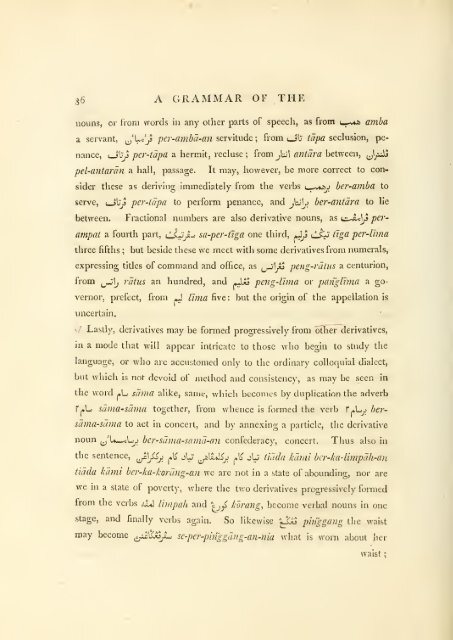A grammar of the Malayan language, with an introduction and praxis..
A grammar of the Malayan language, with an introduction and praxis..
A grammar of the Malayan language, with an introduction and praxis..
You also want an ePaper? Increase the reach of your titles
YUMPU automatically turns print PDFs into web optimized ePapers that Google loves.
36 A GRAMMAR OF THE<br />
nouns, or from words in <strong>an</strong>y o<strong>the</strong>r parts <strong>of</strong> speech, as from i_^v4Jb amba<br />
a serv<strong>an</strong>t, J'l.o'j per-amba-<strong>an</strong> servitude ; from (_Jb" tapa seclusion, pe-<br />
n<strong>an</strong>ce, uJly per-tapa a hermit, recluse; from^bl <strong>an</strong>tara between, ^^^plS<br />
pel-<strong>an</strong>tar<strong>an</strong> a hall, passage. It may, however, be more correct to con-<br />
sider <strong>the</strong>se as deriving immediately from <strong>the</strong> verbs (---v*j»^ ber-amba to<br />
serve, t_Jb^ per-tapa to perform pen<strong>an</strong>ce, <strong>an</strong>d j\ij\j ber-<strong>an</strong>tdra to lie<br />
between. Fractional numbers are also derivative nouns, as (c^y per-<br />
ampat a fourth part, CSjJ.^ sa-per-ttga one third, *J^ CS^ tiga per-lima<br />
three fifths ; but beside <strong>the</strong>se we meet <strong>with</strong> some derivatives from numerals,<br />
expressing titles <strong>of</strong> comm<strong>an</strong>d <strong>an</strong>d <strong>of</strong>fice, as ^^iJu peng-rdlus a centurion,<br />
from ^\j rdtus <strong>an</strong> hundred, <strong>an</strong>d ^^m peng-lima or p<strong>an</strong>glTma a go-<br />
vernor, prefect, from *J lima five : but <strong>the</strong> origin <strong>of</strong> <strong>the</strong> appellation is<br />
uncertain.<br />
\I Lastly, derivatives may be formed progressively from o<strong>the</strong>r derivatives,<br />
in a mode that will appear intricate to those who begin to study <strong>the</strong><br />
<strong>l<strong>an</strong>guage</strong>, or who are accustomed only to <strong>the</strong> ordinary colloquial dialect,<br />
but which is not devoid <strong>of</strong> method <strong>an</strong>d consistency, as may be seen in<br />
<strong>the</strong> word ^U satna alike, same, which becomes by duphcation <strong>the</strong> adverb<br />
r*L sdma-sama toge<strong>the</strong>r, from whence is formed <strong>the</strong> verb r>,L^ bei-<br />
sdma-sama to act in concert, <strong>an</strong>d by <strong>an</strong>nexing a particle, <strong>the</strong> derivative<br />
noun ^^'U-^Lpj ber-sdma-samd-(m confederacy, concert. Thus also in<br />
<strong>the</strong> sentence, ^\J^j ^^ jU ^^la^^ ^^ jIj tiuda kami ber-ka-lmpdh-<strong>an</strong><br />
tidda kdmi ber-ka-kordng-<strong>an</strong> we are not in a state <strong>of</strong> abounding, nor are<br />
we in a state <strong>of</strong> poverty, where <strong>the</strong> two derivatives progressively formed<br />
from <strong>the</strong> verbs *a^ Ihnpah <strong>an</strong>d c^^ kor<strong>an</strong>g, become verbal nouns in one<br />
stage, <strong>an</strong>d finally verbs again. So likewise 'jJUj pinggaiig <strong>the</strong> waist<br />
may become ^^J^ sc-per-pinggdng-<strong>an</strong>-Jiia what is worn about her<br />
waist<br />
;

















